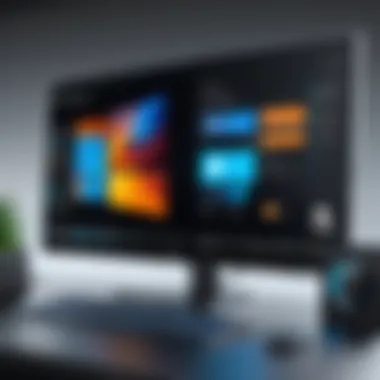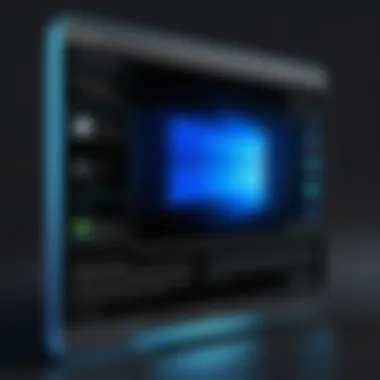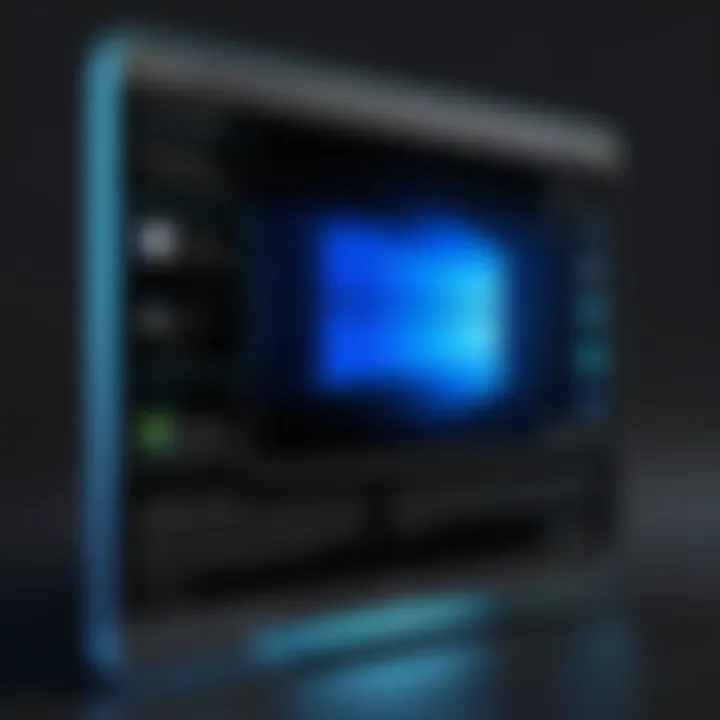Upgrade from Windows 11 Home to Pro: Complete Guide


Intro
The transition from Windows 11 Home to Pro represents a significant upgrade for many users. While Windows 11 Home caters well to casual users, the Pro version brings enhanced features suited for professionals and power users. This guide explores the distinct qualities of each edition, offering insights into their capabilities, the upgrade process, system requirements, and post-upgrade considerations. By understanding the nuances between the two, users can make an informed choice based on their personal or professional computing needs.
Key Features
Distinctive Capabilities
Windows 11 Pro encompasses several features that elevate it beyond its Home counterpart. Notably, it includes advanced security options like BitLocker device encryption, which safeguards sensitive data. Users gain access to Group Policy Management, allowing for tailored settings within organizational environments. Furthermore, Pro supports the ability to join a domain, enhancing enterprise-level collaboration.
Performance Enhancements
This operating system variant optimizes performance for rigorous tasks. Virtualization receives a boost through features such as Hyper-V, enabling users to run virtual machines seamlessly. Moreover, the Pro edition is more suitable for developers and IT professionals due to its support for Windows Sandbox, a safe environment to run untrusted applications.
User Control
Pro users experience greater control over updates through Windows Update for Business. This feature permits deferring updates until they can be tested for compatibility within an organization, creating a more stable environment for productivity.
"Understanding the distinctions between Windows Home and Pro is crucial for achieving optimal performance based on user needs."
Upgrade Advantages
Transitioning to Windows 11 Pro presents various benefits, notably improved security and better management features. For users handling sensitive information or managing teams, these enhancements can be pivotal. The investment in Pro may also reflect in productivity gains through its specialized tools and options.
System Requirements
Before considering the upgrade, it's essential to review the system requirements. Windows 11 Pro requires the same baseline hardware as the Home version, ensuring compatibility. However, users should verify that their devices meet all necessary specifications, including a compatible processor, RAM, and storage capacity.
Upgrade Process
The upgrade process is straightforward. Users can purchase a Windows 11 Pro license through the Microsoft Store or authorized retailers. Once acquired, the process can begin through Settings -> Update & Security -> Activation. Here, users have the option to upgrade and unlock the Pro features with a simple activation key entry.
Post-Upgrade Considerations
Post-upgrade, users may need to familiarize themselves with new features. Exploring the Group Policy Editor and other management tools can enhance overall efficiency. Additionally, users should assess their security settings to utilize all protections available in the Pro version.
Understanding Windows Editions
Understanding the various editions of Windows 11 is essential for users contemplating an upgrade from Windows 11 Home to Pro. Each edition offers distinct features tailored for specific user needs. The Home edition is designed primarily for casual users, while the Pro edition caters to professionals and businesses needing advanced features. Grasping these differences enables users to align their requirements with the capabilities offered, ensuring they choose the right version for their computing environment.
Overview of Windows Home
Windows 11 Home is the entry-level edition of Microsoft's latest operating system. It is geared mostly towards consumers who require a stable and user-friendly environment for everyday tasks like web browsing, media consumption, and basic productivity. Users will find a visually appealing interface with functionalities that support gaming and casual use. Key features include the redesigned Start menu, Snap Layouts for multitasking, and access to the Microsoft Store for apps and games. However, certain advanced functionalities, particularly in security and management, are missing in this edition.
Overview of Windows Pro
Windows 11 Pro, on the other hand, is suited for professionals and businesses. This edition builds on the capabilities of the Home version but incorporates more sophisticated features that help manage devices and secure data. Enhanced security mechanisms such as BitLocker encryption and Windows Information Protection bolster data safety. Pro users also benefit from advanced management features like Group Policy and the ability to connect to a corporate network through Remote Desktop. The Pro edition is more adaptable to the needs of users who require a more robust operating system for demanding tasks.
Key Differences Between Home and Pro Editions


The distinctions between Windows 11 Home and Pro are critical to consider when thinking about an upgrade. Here are some key differences:
- Security Features: Pro offers BitLocker and Windows Information Protection for better data security, absent in Home.
- Management Tools: Group Policy Editor and access to Remote Desktop are exclusive to the Pro version, providing advanced management capabilities.
- Virtualization: The Pro edition supports Hyper-V and Windows Sandbox, which are useful for developers and IT professionals.
Understanding these differences is vital, as they influence both the productivity and security you can expect from your operating system. Whether planning for personal use or business needs, knowing which features are available in each edition aids in making an informed decision.
"Choosing the right Windows edition is not simply about features; it is about aligning those features with your needs."
Reasons to Upgrade to Windows Pro
Upgrading from Windows 11 Home to Pro offers several significant advantages. For users seeking enhanced performance, security, and management features, this transition is worth considering. With the increasing frequency of cyber threats and the demand for better control over computer systems in professional settings, understanding the reason for this upgrade becomes essential. The following sections highlight specific elements that set Windows 11 Pro apart, emphasizing its beneficial aspects and addressing why it resonates with advanced users.
Enhanced Security Features
BitLocker
BitLocker is a critical security feature included in Windows 11 Pro. It encrypts data on the hardware level to protect sensitive information in the event of theft or unauthorized access. This technology is particularly beneficial for enterprises and individuals who handle sensitive data. The key characteristic of BitLocker is its seamless integration with the operating system, allowing for automatic encryption of the drive.
One unique aspect of BitLocker is its ability to protect against cold boot attacks, which can compromise data during the boot process. Although BitLocker provides robust security, a potential drawback is the complexity involved in recovery if users forget their encryption password. This situation can lead to significant data loss, thus it is crucial to store recovery keys securely.
Windows Information Protection
Windows Information Protection (WIP) also stands out as a pivotal security feature in Windows 11 Pro, particularly for businesses. WIP ensures that sensitive information is not leaked outside of an organization through intentional or accidental means. This feature allows IT departments to manage and protect application and data usage without affecting personal apps on users' devices.
The significant advantage of using WIP lies in its balance between security and user privacy. Users can work without restriction, while the organization's data remains protected. However, configuring WIP properly requires considerable IT resources and expertise, which may be a limitation for smaller businesses.
Access to Advanced Management Tools
Group Policy Management
Group Policy Management is an advanced management tool that provides IT departments with control over settings for systems within a network. This is particularly useful for businesses that operate numerous devices under a unified policy framework. The main characteristic of this feature is its capability to reduce administrative overhead by enabling bulk changes to multiple devices simultaneously.
One distinguishing feature is the ability to set user permissions and restrictions efficiently. However, the challenge lies in the steep learning curve associated with mastering Group Policy, making it less accessible for average users or small teams without dedicated IT support.
Remote Desktop
Remote Desktop is another important management tool in Windows 11 Pro. It allows users to access their desktop from any location, providing flexibility for remote work and troubleshooting. The main advantage of this tool is the ability to maintain productivity without being physically present at the workstation.
However, users must be aware of security considerations when using Remote Desktop, as improper configurations can expose systems to vulnerabilities. Therefore, additional security measures, such as Network Level Authentication, should be employed to mitigate these risks.
Improved Virtualization Capabilities
Hyper-V
Hyper-V is a virtualization technology that enables users to create virtual machines on their Windows 11 Pro system. This feature is essential for users who need to test applications in different environments or run multiple operating systems. The unique aspect of Hyper-V is its efficiency in utilizing system resources, allowing for smoother operation of virtual machines.
A significant advantage of Hyper-V is that it allows developers to work on different software versions without impacting their primary system. However, Hyper-V requires additional system resources, so users must ensure their hardware meets these requirements before enabling it.
Windows Sandbox


Windows Sandbox offers a unique environment for safely running untrusted applications. It creates a temporary, isolated desktop environment where users can test software without any risk to the main operating system. This feature is particularly beneficial for those who regularly deal with third-party applications.
While the security benefits of Windows Sandbox are clear, one drawback is its reliance on system resources. Users with limited hardware may find that running the Sandbox affects overall performance. Therefore, it's vital to assess system capabilities before extensively using this feature.
System Requirements for Windows Pro
Understanding the system requirements for Windows 11 Pro is crucial for a successful upgrade. These specifications ensure that your hardware can support the advanced features and capabilities of the Pro edition. Prior to initiating the upgrade, it is essential to assess whether your current setup meets the minimum requirements. Working with incompatible hardware can lead to performance issues or, at worst, system failures.
High-quality performance is not just about having a functioning system. It relates to the fluidity and efficiency of using advanced features like Hyper-V or BitLocker. Ensure that your current device is not only suited for the upgrade, but also capable of meeting the demands of your specific usage.
Minimum Hardware Requirements
The minimum hardware requirements for Windows 11 Pro are a baseline to determine compatibility. Failure to meet these necessities can prevent the installation process altogether. The following are the required components:
- Processor: A compatible 64-bit processor with at least 1 GHz clock speed and at least two cores.
- RAM: Minimum of 4 GB RAM is necessary.
- Storage: At least 64 GB of available storage space.
- TPM: Trusted Platform Module version 2.0 must be enabled.
- Graphics: DirectX 12 compatible graphics with a WDDM 2.x driver.
- Display: A display greater than 9 inches, with HD resolution (720p).
While these specifications are the bare minimum, they serve as a crucial guideline. Users should evaluate their components to ensure compatibility.
Recommended Specifications for Optimal Performance
To fully leverage the capabilities of Windows 11 Pro, it is advisable to consider recommended specifications rather than just the minimum. These specifications can significantly enhance the overall experience, especially for those utilizing advanced features. Consider the following recommendations:
- Processor: A quad-core processor with a clock speed of 2.0 GHz or higher.
- RAM: 8 GB or more is recommended for better multitasking and performance, especially when running heavier applications.
- Storage: At least 256 GB of SSD storage to improve read and write speeds, which enhances system responsiveness.
- Graphics: A newer graphics card that supports DirectX 12 Ultimate to ensure better performance in graphics-intensive tasks.
- Display: A monitor that supports Full HD (1080p) resolution or higher for improved clarity.
Investing in better hardware ensures that you can take full advantage of the features that Windows 11 Pro offers, including enhanced security and improved management tools.
In summary, assessing both minimum and recommended system requirements before upgrading to Windows 11 Pro will aid users in making an informed decision. This careful evaluation helps prevent potential issues from arising, ensuring a smooth transition to the Pro edition.
The Upgrade Process: How to Transition from Home to Pro
The transition from Windows 11 Home to Pro is significant for users looking to unlock a broader range of functionalities and enhanced security features. This section will guide you through the key steps required to execute this upgrade smoothly and efficiently. Understanding this process is imperative, as it ensures that users not only access the advanced tools of the Pro edition but also configure them properly to enhance their computing experience.
Navigating the Upgrade Interface
Starting the upgrade journey begins with the Windows Settings. Navigate to the Settings app by clicking on the Start Menu and selecting the gear icon. Once inside, look for the System section and select About. Here, you will find the option to upgrade to Pro. The interface is designed to be user-friendly, guiding you toward the necessary steps.
Be attentive during this step to read all prompts carefully. The interface may present several informational screens that clarify the benefits of upgrading to Pro. These screens serve as reminders of the enhanced functionality waiting ahead.
Purchasing a License Key for Windows Pro
After accessing the upgrade option, you'll need to purchase a valid license key for Windows 11 Pro. This is a crucial step, as an upgrade is not possible without a genuine key. A few options are available for acquisition. Users can purchase it directly from the Microsoft Store. Another reliable method is through authorized retailers.
When buying, take care to confirm the legitimacy of the vendor to avoid counterfeit keys. Keep the license key handy, as it will be needed to authenticate the upgrade process. Ensure to select the right version - some advertisements may appear misleading.
Installation Steps and Considerations
Upon securing the license key, resume the upgrade process through the Settings app. Enter the key where prompted. The Windows operating system will validate it. If successful, you will start the installation procedure. This phase might involve several reboots, so patience is essential.
Here are steps to follow during installation:


- Accept the license agreement.
- Choose whether to keep your files and apps or start fresh.
- Follow on-screen instructions to finalize the installation.
Considerations include ensuring you have backups of important files before proceeding. Changes to your OS can occasionally lead to unexpected results. Additionally, ensure that your power source is reliable throughout the installation, as interruptions may lead to complications.
Always verify that your system meets the minimum requirements for Windows 11 Pro before starting the upgrade.
In summary, navigating the upgrade process requires attention to detail and preparation. Familiarizing yourself with each step ensures that the transition is seamless, enabling you to take full advantage of Windows 11 Pro's extensive features.
Post-Upgrade Considerations
Post-upgrade considerations are crucial for ensuring that the transition from Windows 11 Home to Pro is smooth and beneficial. After upgrading, users need to assess their new configuration and make necessary adjustments to take full advantage of the Pro features. This section elaborates on three key areas: verifying a successful upgrade, configuring new features and settings, and troubleshooting common issues. These steps help users maximize their experience and mitigate any challenges that might arise.
Verifying Successful Upgrade
After upgrading to Windows 11 Pro, it is vital to confirm that the operation was successful. This verification process ensures that all features and settings of the Pro edition are functioning as intended. To verify your upgrade, follow these steps:
- Check Windows Version: Go to Settings, then select System, and click on About. Under the Windows specifications, check the edition. It should state Windows 11 Pro.
- Feature Availability: Test critical features unique to Pro. Try accessing Group Policy Editor by typing in the Run dialog (Windows + R). If it opens successfully, the upgrade is confirmed.
- Update Settings: Ensure that Windows Update settings are set properly under Settings > Update & Security > Windows Update.
This verification process plays an important part in determining if additional steps are necessary to fully enable your upgraded system.
Configuring New Features and Settings
With the upgrade to Windows 11 Pro, users gain access to various advanced features. Configuration of these elements is imperative to enhance productivity and security. Below are some common configurations:
- BitLocker: Enable full disk encryption for added security. This can be done through the Control Panel under System and Security > BitLocker Drive Encryption.
- Group Policy Management: Adjust settings that control the user environment and system behavior. Access this through the Group Policy Editor.
- Remote Desktop: Configure Remote Desktop settings to allow external access to your PC. Go to Settings, then to System, and choose Remote Desktop. Enable it for remote access.
Appropriate configuration not only secures your device but also leverages the full potential of Windows 11 Pro.
Troubleshooting Common Upgrade Issues
Despite the upgrade's advantages, issues may occur. Familiarizing with common problems can ease the transition. Here are some issues and their solutions:
- Activation Problems: If Windows 11 Pro does not activate properly, ensure the license key is entered correctly. Check the Settings > Update & Security > Activation for troubleshooting options.
- Driver Compatibility: After the upgrade, some drivers may be incompatible. Ensure that all drivers are updated. This can be done via Device Manager.
- Performance Issues: If the system shows sluggish behavior, consider performing a clean installation or resetting your PC. Backup your files before initiating this process.
Resolving these common problems quickly minimizes disruption and maintains productivity.
In summary, addressing post-upgrade considerations can distinctly influence the effectiveness of your upgraded system. Verifying the upgrade, configuring new features, and troubleshooting any potential issues are all integral steps to ensure a seamless and satisfying transition to Windows 11 Pro.
End: Is the Upgrade Worth It?
Deciding whether to upgrade from Windows 11 Home to Pro requires thoughtful consideration of your specific needs. The differences between these two editions can have significant implications. Windows 11 Pro offers features aimed at businesses and power users that may enhance productivity and security. However, for general users, Windows 11 Home might suffice.
Evaluating Personal Needs and Use Cases
It is crucial to evaluate your personal computing needs before making the upgrade. Here are several aspects to consider:
- Usage Type: Identify how you use your computer. If you rely on advanced features such as virtualization or Group Policy Management, Windows 11 Pro may be the right choice. However, if casual browsing, streaming, and basic tasks define your usage, the Home version is likely adequate.
- Security Requirements: Assess your need for enhanced security tools. If you work with sensitive information, features like BitLocker encryption found in Pro may protect your data more effectively.
- Remote Work Capabilities: For those whose work demands remote access, Windows 11 Pro’s Remote Desktop feature is a notable benefit, enabling users to connect to their work computers easily.
Understanding these use cases helps frame whether the benefits offered by Windows 11 Pro justify the cost.
Long-Term Benefits of Upgrading
Upgrading to Windows 11 Pro carries several long-term benefits that can enhance your computing experience. Consider the following:
- Future-Proofing: As software evolves, having a more robust operating system ensures compatibility with future applications and updates. Windows 11 Pro will likely offer support for more advanced features.
- Access to Business Tools: The ability to access advanced management tools can open up opportunities for users interested in developing their professional skills or enhancing their work environments. Features such as virtualization can be particularly useful for software developers and IT professionals.
- Enhanced Productivity: The tools available in Pro can improve workflow. Users can manage system settings with greater control, optimize resource allocation, and minimize downtime, leading to an overall increase in productivity.
In summary, weighing your current and future needs against the features offered by Windows 11 Pro is essential. This evaluative process empowers users to make an informed decision regarding whether the upgrade is worth the investment.



